21 Nov Yucatan — Splashing in the Mayan Underworld
The Yucatan is one enormous slab of limestone riddled with caves. Or, maybe, just one huge cave that runs through the whole thing. Nobody really knows because nobody has been able to walk around in them since the oceans rose at the end of the last Ice Age and filled them with seawater.
Because there aren’t any rivers in Yucatan, rain doesn’t run off. It sinks into the limestone, creating a thirty-foot lake of fresh water floating on top of the saltwater. In something like 6,000 places where the cave had collapsed into cenotes that look to Norteamericanos like nothing so much as abandoned rock quarries.
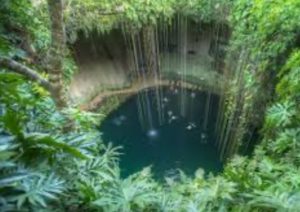
For Mayans, cenotes were places to get a drink. And to toss beaten gold, carved jade, jewelry, idols, pottery, copper bells, and the occasional human when times got tough and the god of the Underworld needed cozying up to. The Mayans might have been on to something. If you wanted to get to the Underworld, those cenotes would be a pretty good place to enter.
One of the things I’d told myself . . . and promised Peg . . . was that we would never dive in a cave. If we needed to come up quickly, I didn’t want us to smack into solid rock while we were still underwater, I wanted to burst out into fresh air and sunlight. That was pretty much the same thing I’d promised about not swimming inside sunken ships. Before I found out about Truk Lagoon. Or not venturing into deep water. Before getting distracted by a really beautiful eel garden at a-hundred-and-some feet on the Great Barrier Reef.
“Cenotes aren’t caves,” the dive people explained to us. “Cenotes are caverns, and caverns are safe to dive in.”
Well OKAY, then, I thought, the caves in Yucatan are nothing but caverns. One of the things I’ve always admired about Mexicans is how they don’t allow lawyers to bully all the fun out of life.
“Caverns,” Peggy said, “sound a lot like caves to me,” and I think she would have sat this one out if our guide hadn’t been named Marina. How can you go wrong with a dive guide named Marina?” So, it was into a jeep, followed by two hours of jouncing along jungle roads then, into the water.
We didn’t enter by way of one of the cenotes. We went in through what looked like the kind of spring you’d dip water out of.
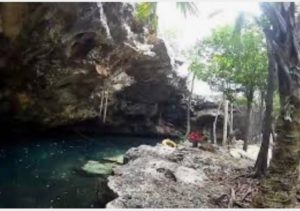
Inside, was a rope. The cavern we were diving in had a rope on the bottom.
Following a rope is pretty much de rigueur in the world of cave diving. It’s how you find your way back out. Which made the place we were in look suspiciously cave-like. And there were stalactites.
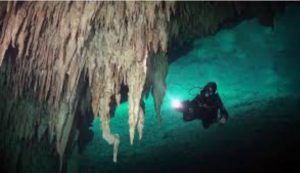
Real, by-gosh stalactites that we could swim around like slow-moving bats.
I’m not sure of the optics here, but the water seemed to absorb the light from the entrance and spread it around or, maybe, refract and scatter it, so the darkness seemed to glow and we could see to move around. At least, at first. But after a while, the glow gave out and the cavern turned more cave-like than ever.
We had lights we could shine around and get glimpses of bits of things, one of the things being the stalactites sticking up below us. I’m not talking stalagmites, here. I’m talking stalactites. Stalactites that looked a lot like the ones where we were. stalactites we were swimming among in an upside-down sort of way.
Where the ocean meets the fresh water, they don’t mix. They just lay there mirror-flat in what’s called a halocline. And, since salt water and fresh water have different refractive indices, the place they meet isn’t just like a mirror, it is a mirror. A mirror where we could admire ourselves swimming among stalactites. It was magical and unexpected and playful and takes my breath away when I remember it.
We descended and met ourselves at the halocline and slid through and located the rope and followed it, and followed Marina, until she gestured us to ascend.
We bobbed about in dark, and took off our masks, and shone our lights around a big, domed space that, in a tourist cave, would be the Grand Ballroom. Except this was a ballroom with roots coming down from the ceiling, some as massive as tree trunks. Big, wooden columns as flared out at the bottom as cartoon elephant trunks. Or intakes to industrial vacuums.

It was enough to make you wonder whether the trees were anything more than tree-size pegs set into holes in the limestone. And ask yourself, what is the coefficient of friction of limestone? And whether, during the rainy season, things don’t become a bit slippery. And what would happen if a jaguar landed on one of the trees. Or, a flock of birds settled in, or excitable monkeys, and the whole system became overloaded and slammed down like a portcullis. The dive shop didn’t mention anything about that when they were selling cavern dives.
Trying to work out physics problems in our heads, we descended into the darkness, followed the rope and . . . everything being connected to everything else . . . passed beneath a big, sunlit cenote.
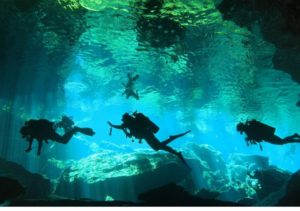
From twenty, twenty-five feet down, we could see the Mexican sky, the silvers and white of the limestone, the greens and yellows and golds of foliage leaning over the edge.
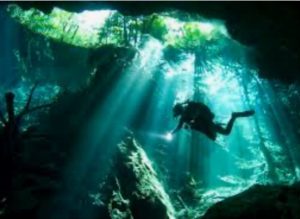
It was astonishingly beautiful. A beauty that none of the Mayans, none of the Conquistadores, nobody in the world before our fortunate generation ever saw. Except, perhaps, a few sacrificial victims on their way to the Underworld. And nobody ever reported back on.


No Comments